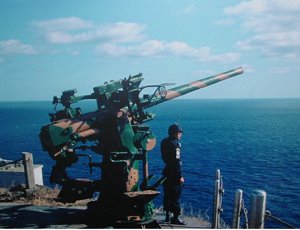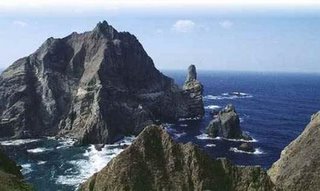
Sixteen members of the Foreign Correspondents' Club of
Japan have signed up for a visit later this month to a
pair of South Korean-controlled islets claimed by
Tokyo, sources familiar with the planned trip said
Friday.
The 16 participants, including two Japanese, will
travel on a Korean Coast Guard ship to visit the
disputed territory known as Takeshima in Japan and
Dokdo in South Korea as part of their July 23-25 trip,
the sources said.
According to the FCCJ, the group will arrive in Seoul
on July 23 and proceed to Mukho port. It will leave
Mukho by Korean Coast Guard vessel for Ullungdo and
later visit Dokdo.

After spending a minimum one hour on Dokdo, the group
will return to Mukho, where it will stay overnight
before leaving for Seoul on July 25, the press club
said.
Yoshinori Katori, the Foreign Ministry's press
secretary, told FCCJ President Dennis Normile and his
predecessor Daniel Sloan earlier this month that the
Japanese government's position is that going to the
disputed islets through South Korea implies
recognition of South Korean sovereignty.
Normile said he and Sloan told Katori that the FCCJ is
"completely neutral on the sovereignty issue."
(Wire news July 14,06)

Histoire (Francais) :
La question de Takeshima
1. La position du Japon
(1) Au regard de l?histoire et du droit international,
il est clair que Takeshima fait partie intégrante du
territoire japonais.
(2) L?occupation de Takeshima par la République de
Corée est illégale, sans aucun fondement légal du
point de vue du droit international. Toutes les
mesures concernant Takeshima que la République de
Corée prend, sur la base de cette occupation illégale,
n?ont aucune valeur juridique.
(Note : La République de Corée n?a jamais apporté de
preuves claires permettant de justifier ses
prétentions selon lesquelles elle aurait établi une
autorité effective sur Takeshima avant l?établissement
de l?autorité effective et de la souveraineté du Japon
sur Takeshima.)
2. Les thèses du Japon concernant la souveraineté sur
Takehima
(1) Réalité historique sur la souveraineté de
Takeshima
A la lumière de la réalité historique, rappelée
ci-dessous, il est évident qu?au milieu du
dix-septième siècle, au plus tard, le Japon a établi
sa souveraineté sur Takeshima en s?appuyant sur une
autorité effective ; ce qui a été réaffirmé par le
Japon moderne en 1905, Takeshima étant toujours
effectivement sous l?autorité du Japon.
(a) Le Japon connaissait depuis très longtemps
l?existence de Takeshima (alors connue sous le nom de
Matsushima). Cela est confirmé dans de nombreux
écrits et sur quantité de cartes.
(Note : Sur le Kaisei Nippon Yochi Rotei Zenzu (Carte
complète révisée des régions et routes japonaises ?
1779) de Sekisui Nagakubo, qui est la publication
cartographique la plus représentative du Japon,
Takeshima est localisée précisément sur son
emplacement actuel. Plusieurs autres documents avant
l?ère Meiji en font aussi état.)
(b) Au début de l?époque d?Edo (1618), les familles
Ohya et Murakawa du fief de Houki reçurent du shogunat
des Tokugawa l?autorisation d?exercer leurs droits
féodaux sur l?île d?Utsuryo. Ces familles y menèrent
ensuite des opérations de pêches, sur l?île, et autour
de celle-ci, envoyant chaque année au shogunat une
partie des ormeaux qu?elles y avaient attrapés pour
payer leur tribut. Takeshima qui se trouvait sur le
trajet menant à l?île d?Utsuryo était un port de pêche
et un lieu d?escale. De plus, en 1661, au plus tard,
les familles Ohya et Murakawa reçurent du shogunat
l?autorisation d?exercer leurs droits féodaux sur
Takeshima.
(c) En 1696, à la suite de négociations menées entre
le Japon et la Corée concernant la pêche à proximité
de l?île Utsuryo, le shogunat interdit la circulation
des bateaux autour d?Utsuryo, mais pas de Takeshima.
(d) En 1905, le Japon réaffirma son intention de
continuer à posséder Takeshima par une décision du
Conseil des ministres en janvier, suivie d?une
déclaration de la Préfecture de Shimane en février,
qui intégrait Takeshima au sein de la Préfecture de
Shimane. Par la suite, Takeshima fut mentionné sur le
registre foncier officiel, et un permis de chasse à
l?otarie sur l?île de Takeshima fut instauré, jusqu?à
sa suppression, en 1941, lors de la Seconde guerre
mondiale.

(2) Validité de l?intégration de Takeshima par le
gouvernement japonais en 1905
Les mesures prises pour intégrer Takeshima à la
Préfecture de Shimane en 1905 réaffirmèrent
l?intention du gouvernement japonais de se prévaloir,
en tant qu?état moderne, de droits territoriaux sur
Takeshima. Elles ne peuvent nullement être
interprétées d?une manière qui pourrait laisser penser
que le Japon ne possédait pas Takeshima avant cela, et
que d?autres pays étaient en possession de Takeshima.
De plus, l?intégration de Takeshima fut relayée par la
presse écrite et ne s?est pas faite dans le secret.
Par conséquent, elle a été réalisée effectivement.
(Note : le droit international ne fait pas obligation
d?informer les gouvernements étrangers de mesures qui
intègrent des territoires.)
(3) En septembre 1954, le Japon proposa, dans une note
verbale, à la République de Corée de saisir la Cour
internationale de justice afin de pouvoir régler le
différend ; mais la République de Corée n?accepta pas
cette proposition.
Lors d?une réunion ministérielle, en mars 1962, le
Ministre japonais des Affaires étrangères proposa de
nouveau à son homologue coréen de saisir, une nouvelle
fois, la Cour internationale de justice, ce qui fut
accueilli défavorablement par les Coréens.
www.fr.emb-japan.go.jp/act/gd/06_takeshima.html

History (English)
The tiny islets, about equidistant between Japan and
South Korea, are held by Seoul but claimed by Tokyo
after its colonial occupation of Korea in 1910-1945. A
South Korean garrison has occupied the two tiny
islands since 1954. In 1965 talks to normalise
relations between the two countries saw discussions
about the issue postponed. Talks held in 1996 about
their respective maritime borders were interrupted in
2000. The latest move is part of a series of mutual
provocations that began last year when the governments
of both countries started sending warships and survey
vessels to the islands. Under international law, each
country has rights to explore and use marine resources
within 370 kilometres from its shores. It seems there
is no doubt, from a historical perspective, that Korea
should enjoy sovereignty of the islands. Prof Mark
Seldon of Cornell University said: ?Data from
historical archives bear Korea out. It can claim
possession from the time of the Silla Dynasty (in 8th
century).? Japanese diplomacy has sought to overrule
the case of history by presenting a document stating
that the Kingdom of Korea ceded the two islets to
Japan in 1905, but no one has able to prove its
authenticity.









